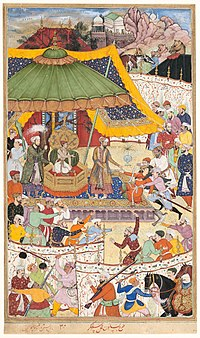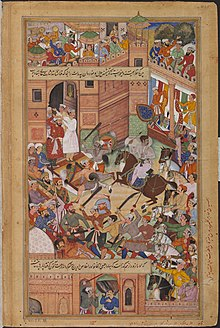Introduction
Ain-i-Akbari, the third volume of the Akbar Nama, includes details about the Akbari administration, including its different agencies, ranks, etc. All of the histories that were written in India during the Muslim period were mainly chronologies of the events they detailed. The common people are rarely addressed unless there are famines or other natural catastrophes with high mortality details. The Ain-i-Akbari, however, is a work with a special identity. Along with imperial institutions, nobles, and establishment figures of the empire, this book describes people working in a variety of sectors and occupations.
Meaning of Ain-i-Akbari
The Mughal Empire’s great ruler Akbar’s constitution or government is known by the term “Ain-i-Akbari.” Written in Farsi in the sixteenth century, this work. According to the author, Abu’l-Fuzzle was one of Akbar’s royal palace’s nine jewels (also known as Navaratnas in Hindi). According to reports, he took seven years to finish the work. Numerous miniature paintings of the original text were donated by the top artists of the Mughal school of painting and masters of the royal workshops, including Basawan, whose use of portraiture in images marked a milestone in Indian art. It is assumed that the writing dates from between 1592 and 1594.

Akbar Nama and Ain-i-Akbari
Abu’l-Fuzle Three volumes of the chronicle of Akbar’s reign were written by Ibn Mubarak, one of Akbar’s best friends and a court administrator. This book’s name was Akbar Nama. Akbar’s ancestors are covered in the first book, and the events of his rule are covered in the second volume’s chronology. Volume 3 was titled Ain-i Akbari and covered the governance, domestic life, armed forces, finances, and regional distribution of Akbar’s dominion. Information about Indian traditions and society is also included in the text. The most effective aspects of Ain-i Akbari are its detailed data on a range of topics, including commodities, outputs, prices, salaries, and revenue.
Many modern historians have long thought about the significant systemic changes in Mughal rule and the changes in Akbar’s managerial and religious policies in the years leading up to his death.
Significance of Akbar Nama & Ain-i-Akbari
Ain-i-Akbari, the third book of the Akbar Nama (1556-1605 CE), was authored by Abu-l-Fazl, the royal historian of Emperor Akbar. While Akbar Nama is a historical work, Ain-i-Akbari is a collection of rules and laws that Akbar drafted and put into effect to promote good government. The Ain-i-Akbari law describes Akbar’s reign in depth, including the numerous divisions, their different classes, and more. All history that has been written about India during the Islamic period is mainly documented chronologically, with battles, conquests, and dynasty changes.
with the exception of famine and other severe natural disasters, the general population is rarely discussed. Ain-i-Akbari, however, is a work with a distinct spirit. Along with imperial organizations, aristocrats, and empire ancestors, this book also profiles individuals employed in a variety of sectors and occupations. Imperial Harlem, culinary and serving utensils, fragrances, creatures like horses and elephants, and the spring and autumn vegetable crops are among the subjects covered. The Muslim population as well as the local Hindu, Jain, and other groups are discussed in this work along with their social background, writing aspirations, and pursuits in law and philosophy. Chapters on famous tourists, Muslim saints, and Sufis are also included.
Another issue Abu’l-Fuzzle talks about with the throng of people is the caste system. It lists each caste’s name, title, and responsibilities. The combination of four fundamental classes yields 16 subcategories, which are discussed in the resultant text. Following that, he spoke about karma, calling it “a truly remarkable kind of knowledge system on which Hindustani academics concur without distinction.” Based on what happens in the next world, he categorises human behaviour into four groups.
Summary
Abul Fazal was one of Akbar’s court’s most successful historians, and his books “AkbarNama” and “Ain-e-Akbari” are scriptures to his comprehensive understanding and knowledge of Persian writing. The Ain-i-Akbari, also known as the “Constitution of Akbar,” is a comprehensive work that chronicles the governance of the kingdom of Akbar’s vizier Abu’l-Fazl ibn Mubarak and was composed in the 16th century. It is the third and final book of the three-volume Akbarnama, also known as the Book of Akbar, which Abul Fazl also published.
Frequently Asked Questions
1. Which volume of Akbar Nama book is known as Ain-i-Akbari?
Information about Akbar’s rule can be found in Akbar Nama, volume 3. Because it correctly captures the time of Akbar’s rule, The AkbarNama is an especially valuable literary work for historians. It offered a thorough evaluation of the Mughal Kingdom in all its facets. Ain-e Akbar is basically a unique work because it departs from the previous works’ formulaic storytelling and provides an exhaustive account of Akbar’s India. The self-assured, endearing, and frequently exaggerated writing style of Akbarnama was regarded as the apex of historical literature and was copied in later years.
2. Who gained authority after Akbar’s death?
The Mughal dynasty’s most illustrious monarch, Akbar, passed away on October 29, 1605. After his demise, Nur-ud-din Salim Jahangir became the next ruler of India.
3. Who was the final ruler of the Mughals?
The last Mughal ruler, Bahadur Shah II, also known as Zafar, died in British imprisonment in Burma in 1862. As the last of a dynasty line that dated back to the fifteenth century, he had headed a court that was well-educated in culture in his earlier years. However, as the British East India Company expanded.
